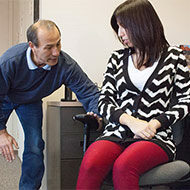Practice proper workplace ergonomics

Do you sit at a desk for hours at a time for work? Do you ever feel sore, experience back or neck pain, or have pain in your fingers? If so, you may not be practicing proper ergonomics. Mayo Clinic recommends following these tips to help make your workstation more ergonomically correct:
- Ensure your chair is adjusted so your feet rest on the floor and your knees are level with your hips. Use a footrest if your chair is too high for you to comfortably rest your feet on the floor. No lumbar support? Use a cushion between the curve of your back and the back of your chair.
- Keep items you regularly use – including the telephone or a stapler – close to your body to avoid unnecessary stretching throughout the day.
- Position your computer mouse close to your keyboard, and keep your wrist relaxed when using the mouse.
- Keep your wrist in a straight position when typing – not bent up or down – and consider using a wrist rest to help minimize stress.
- Do you talk a lot on the phone? Cradling a phone between your head and neck can cause strain. Use a headset to eliminate this issue.
- Pay attention to your posture. Keep your body centered in front of your monitor and keyboard, and your thighs horizontal with your knees.
- Make sure you have plenty of space under your desk for your legs, knees and thighs. Mayo Clinic recommends having a desk at least 19 inches deep, 30 inches wide and up to 34 inches high (depending on your height).
- Keep your monitor about an arm’s length in front of you.
- To help avoid glare, keep the brightest light source in your office to the side of your monitor.
See also:
Office worker ergonomics
Safety+Health shares – in pictures – how the National Safety Council conducts ergonomics assessments of workers’ desks and chairs to help prevent MSDs.

